 CS 596 Client-Server Programming
CS 596 Client-Server Programming
Names, Style, Frameworks
[To Lecture Notes Index]
San Diego State University -- This page last updated May 2, 1996

Contents of Names, Style, Frameworks Lecture
- References
- Names
- Conceptual Level Definition
- Comments
- Kinds of Comments
- Commenting Efficiently
- Commenting Techniques
- Commenting Individual Lines
- Commenting Paragraphs of Code
- Commenting Data Declarations
- Commenting Routines
- Frameworks and Libraries
Code Complete, Steve McConnell, Microsoft Press, 1993, chapter 19,
chapter 9
Part of these notes follow very closely chapter 19 in Code Complete.
Nearly all examples are taken directly from Code Complete. I have used
the same headers and main points of the text.
"Finding good names is the hardest part of OO Programming"
"Names should fully and accurately describe the entity the variable
represents"
What role does the variable play in the program?
| Data Structure | Role, function |
| InputRec | EmployeeData |
| BitFlag | PrinterReady |
Some Examples of Names, Good and Bad
| TrainVelocity | Velt, V, X, Train |
| CurrentDate | CD, Current, C, X, Date |
| LinesPerPage | LPP, Lines, L, X |
OOP Names - Common Problems
class Stack
{
Vector theStack = new Vector();
public void push( object x )
{
theStack.add( x );
}
// code deleted
}
class DriverProgram
{
public void static main( String[] args )
{
// blah blah blah
Stack stack;
aFooFunction( stack );
// more blah
}
void aFooFunction( Stack aStack )
{
}
}
Object-Oriented Programming
Abstraction
"Extracting the essential details about an item or group of items, while
ignoring the unessential details."
Edward Berard
"The process of identifying common patterns that have systematic variations; an
abstraction represents the common pattern and provides a means for specifying
which variation to use."
Richard Gabriel
Example
Pattern: Priority queue
Essential Details: length
items in queue
operations to add/remove/find item
Variation: link list vs. array implementation
stack, queue
Object-Oriented Programming
Conceptual Level DefinitionEncapsulation
Enclosing all parts of an abstraction within a container
Example
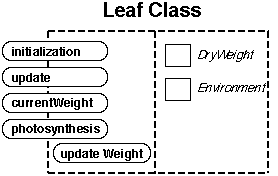
Object-Oriented Programming
Conceptual Level DefinitionInformation Hiding
Hiding parts of the abstraction
Example
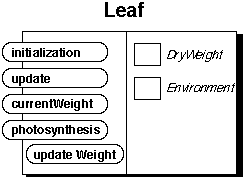
Object-Oriented Programming
Conceptual Level DefinitionHierarchy
Abstractions arranged in order of rank or level
Class Hierarchy
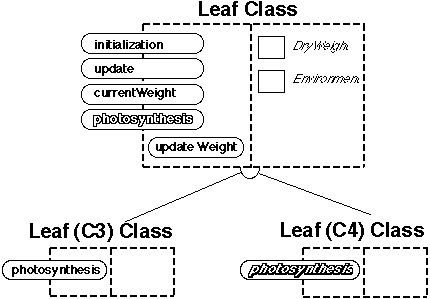
Object-Oriented Programming
Conceptual Level DefinitionHierarchy
Object Hierarchy
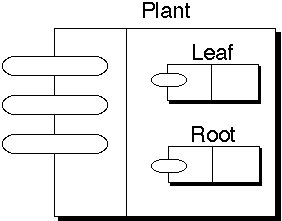
"Comments are easier to write poorly than well, and comments can be more
damaging than helpful"
What does this do?
for i := 1 to Num do
MeetsCriteria[ i ] := True;
for i := 1 to Num / 2 do begin
j := i + i;
while ( j <= Num ) do begin
MeetsCriteria[ j ] := False;
j := j + i;
end;
for i := 1 to Mun do
if MeetsCriteria[ i ] then
writeln( i, ' meets criteria ' );
How many comments does this need?
for PrimeCandidate:= 1 to Num do
IsPrime[ PrimeCandidate] := True;
for Factor:= 1 to Num / 2 do begin
FactorableNumber := Factor + Factor ;
while ( FactorableNumber <= Num ) do begin
IsPrime[ FactorableNumber ] := False;
FactorableNumber := FactorableNumber + Factor ;
end;
end;
for PrimeCandidate:= 1 to Num do
if IsPrime[ PrimeCandidate] then
writeln( PrimeCandidate, ' is Prime ' );
Good Programming Style is the Foundation of Well Commented Program
X := X + 1 /* add one to X
/* if allocation flag is zero */
if ( AllocFlag == 0 ) ...
- Used to explain complicated or tricky code
*p++->*c = a
/* first we need to increase p by one, then ..
-
-
- Make code simpler before commenting
(*(p++))->*c = a
ObjectPointerPointer++;
ObjectPointer = *ObjectPointerPointer;
ObjectPointer ->*DataMemberPointer = a;
/* **** Need to add error checking here **** */
- Distills a few lines of code into one or two sentences
-
-
-
- Description of the code's intent
- Explains the purpose of a section of code
{ get current employee information } intent
{ update EmpRec structure } what
- Use styles that are easy to maintain
/***********************************
* module: Print *
* *
* author: Roger Whitney *
* date: Sept. 10, 1995 *
* *
* blah blah blah *
* *
***********************************/
/***********************************
module: Print
author: Roger Whitney
date: Sept. 10, 1995
blah blah blah
***********************************/
Avoid self-indulgent comments
MOV AX, 723h ; R. I. P. L. V. B.
Endline comments have problems
MemToInit := MemoryAvailable(); { get memory available }
- Not much room for comment
-
- Must work to format the comment
Use endline comments on
- Data declarations
-
- Maintenance notes
-
- Mark ends of blocks
Write comments at the level of the code's intent
Comment the why rather than the how
Make every comment count
Document suprises
Avoid abbreviations
How verses Why
How
/* if allocation flag is zero */
if ( AllocFlag == 0 ) ...
Why
/* if allocating a new member */
if ( AllocFlag == 0 ) ...
Even Better
/* if allocating a new member */
if ( AllocFlag == NEW_MEMBER ) ...
Summary comment on How
{ check each character in "InputStr" until a
dollar sign is found or all characters have
been checked }
Done := false;
MaxPos := Length( InputStr );
i := 1;
while ( (not Done) and (i <= MaxLen) ) begin
if ( InputStr[ i ] = '$' ) then
Done := True
else
i := i + 1
end;
Summary comment on Intent
{ find the command-word terminator }
Done := false;
MaxPos := Length( InputStr );
i := 1;
while ( (not Done) and (i <= MaxPos ) ) begin
if ( InputStr[ i ] = '$' ) then
Done := True
else
i := i + 1
end;
Summary comment on Intent with Better Style
{ find the command-word terminator }
FoundTheEnd := false;
MaxCommandLength := Length( InputStr );
Index := 1;
while ((not FoundTheEnd) and
(Index <= MaxCommandLength)) begin
if ( InputStr[ Index ] = '$' ) then
FoundTheEnd := True;
else
Index := Index + 1;
end;
Comment the units of numeric data
Comment the range of allowable numeric values
Comment coded meanings
var
CursorX: 1..MaxCols; { horizontal screen position of cursor }
CursorY: 1..MaxRows; { vertical position of cursor on screen }
AntennaLength: Real; { length of antenna in meters: >= 2 }
SignalStrength: Integer; { strength of signal in kilowatts: >= 1 }
CharCode: 0..255; { ASCII character code }
CharAttib: Integer; { 0=Plain; 1=Italic; 2=Bold }
CharSize: 4..127; { size of character in points }
Comment limitations on input data
Document flags to the bit level
Avoid Kitchen-Sink Routine Prologs
Keep comments close to the code they describe
Describe each routine in one or two sentences at the top of the routine
Document input and output variables where they are declared
Differentiate between input and output data
Document interface assumptions
Keep track of the routine's change history
Comment on the routine's limitation
Document the routine's global effects
Document the source of algorithms that are used
procedure InsertionSort
{
Var Data: SortArray; { sort array elements }
FirstElement: Integer {index of first element to sort}
LastElement: Integer {index of last element to sort}
}
"A framework is a set of cooperating classes that make up a reusable
design for a specific class of software"
- Peter Deutsch
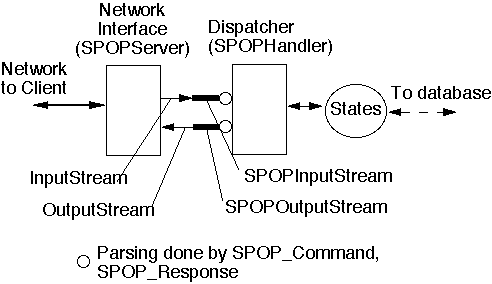
Java API
| Applet | DatagramSocket | ImageProducer | RandomAccessFile |
| AppletContext | Date | IndexColorModel | Rectangle |
| AppletStub | DebuggerCallback | InetAddress | Runnable |
| AudioClip | Dialog | Insets | Runtime |
| BitSet | Dictionary | Integer | RuntimeConstants |
| Boolean | Dimension | Label | Scrollbar |
| BorderLayout | DirectColorModel | LayoutManager | SecurityManager |
| Button | Double | List | ServerSocket |
| Canvas | Enumeration | LocalVariable | Socket |
| CardLayout | Event | Long | SocketImpl |
| Character | Field | Math | SocketImplFactory |
| Checkbox | File | MediaTracker | Stack |
| CheckboxGroup | FileDescriptor | MemoryImageSource | StackFrame |
| CheckboxMenuItem | FileDialog | Menu | String |
| Choice | FilenameFilter | MenuBar | StringBuffer |
| Class | FilteredImageSource | MenuComponent | StringTokenizer |
| ClassLoader | Float | MenuContainer | System |
| Cloneable | FlowLayout | MenuItem | TextArea |
| Color | Font | Number | TextComponent |
| ColorModel | FontMetrics | Object | TextField |
| Compiler | Frame | Observable | Thread |
| Component | Graphics | Observer | ThreadDeath |
| Constants | GridBagConstraints | Panel | ThreadGroup |
| Container | GridBagLayout | PixelGrabber | Throwable |
| ContentHandler | GridLayout | Point | Toolkit |
| ContentHandlerFactory | Hashtable | Polygon | URL |
| CropImageFilter | Image | Process | URLConnection |
| DataInput | ImageConsumer | Properties | URLEncoder |
| DataOutput | ImageFilter | RGBImageFilter | Vector |
| DatagramPacket | ImageObserver | Random | Window |
STREAMS
| BufferedInputStream | InputStream |
| BufferedOutputStream | LineNumberInputStream |
| ByteArrayInputStream | OutputStreamPipedInputStream |
| ByteArrayOutputStream | PipedOutputStreamPrintStream |
| DataInputStream | PushbackInputStream |
| DataOutputStream | SequenceInputStreamStreamTokenizer |
| FileInputStream | StringBufferInputStream |
| FileOutputStream | URLStreamHandler |
| FilterInputStream | URLStreamHandlerFactory |
| FilterOutputStream | |


 CS 596 Client-Server Programming
CS 596 Client-Server Programming CS 596 Client-Server Programming
CS 596 Client-Server Programming